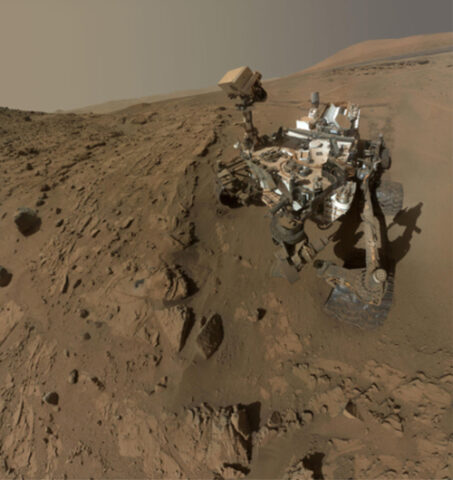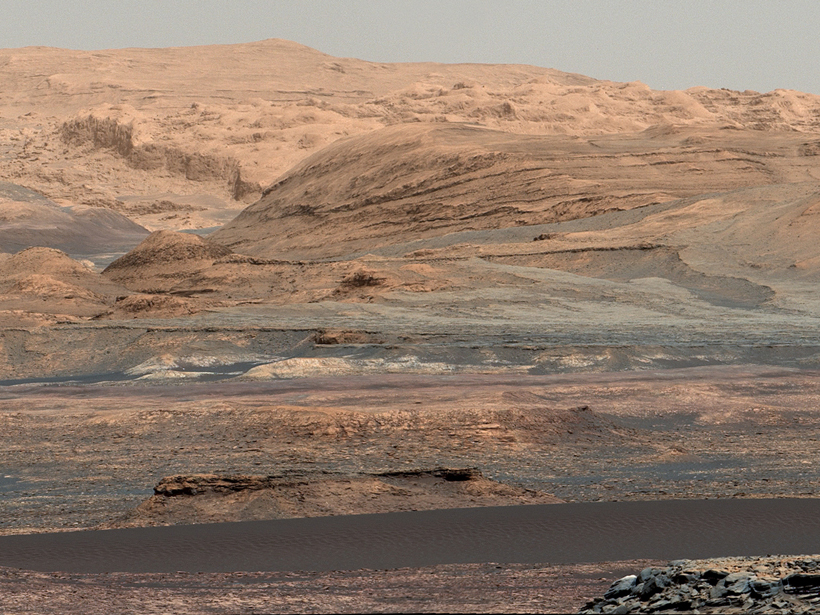
“Time to see where our Curiosity will take us.” Those were the words of Flight Controller Allen Chen as NASA’s Mars rover Curiosity touched down in August 2012. The dramatic landing was a success in its own right, demonstrating a new system in which a rocket-powered “skycrane” lowered the 1-ton rover to the surface of Mars within just 2.5 kilometers of its target. But it also marked the beginning of a rich and exciting scientific journey focused on revealing the habitability of ancient Mars.
The Mars Science Laboratory (MSL) mission [Grotzinger et al., 2012, 2015a], with its Curiosity rover (Figure 1), was conceived as a mobile geochemical laboratory. For the past 3.5 years, the rover has traversed the rugged terrain of Gale Crater, carrying out its chief objective: to quantitatively assess whether early Mars could have supported microbial life.
To do so, Curiosity looked for geologic and environmental clues to determine the availability and chemistry of water, the presence of carbon and other key elements required by life, sources of energy that could sustain metabolism, and the absence of chemical or environmental hazards.
A Mobile Martian Laboratory
In 2004, NASA selected a payload of 10 instruments designed to accomplish these challenging analytical measurements, as well as the geological field work necessary to uncover the ancient history of the environment. These instruments include high-definition imagers; a laser-induced breakdown spectrometer that carries out point chemical analyses; a neutron spectrometer that measures hydrogen abundance; an X-ray spectrometer mounted to the arm that can perform bulk elemental analyses; an X-ray diffractometer that can analyze mineralogy; and a combined mass spectrometer, gas chromatograph, and tunable laser spectrometer (GCMS-TLS) that analyzes volatiles, isotopes, redox states, and organic carbon.
Altogether, Curiosity’s payload allows it to carry out the first comprehensive chemical and mineralogical descriptions of Martian surface materials. The payload and the science team that oversees it are distinctly international, with three instruments and parts of others provided by Canada, Russia, Spain, France, Germany, and Finland. Forty percent of the mission’s nearly 500 science team members are based outside of the United States.
NASA chose the mission’s landing site through a multiyear study by the MSL project and members of the Mars and terrestrial science communities. After scrutinizing the scientific value and safety characteristics of 60 candidate sites, the study settled on Gale Crater. The 154-kilometer-diameter crater contains a 5-kilometer-high central mound of stratified, sedimentary rock named Aeolis Mons (informally called Mount Sharp).
Satellite imagery appears to show numerous water-shaped landscapes, and spectroscopy has revealed iron oxide, clays, and sulfates—mineralogy that occurs when water and rock interact. The extensive and variable stratigraphic record offers Curiosity the chance to explore multiple potentially habitable environments, with the additional and important opportunity to derive key environmental transitions from the geologic record.
Yellowknife Bay: An Ancient Martian Habitat
Curiosity carried out its first in-depth investigation at Yellowknife Bay, an expanse of bedrock forming the outer edge of a fan of debris that appears to have been deposited by an ancient river flowing from the northern crater rim. En route, the rover came across outcrops that were clearly formed by flowing water, consisting of rounded pebbles cemented together like river sediment.
The team hypothesized that the fine-grained mudstone at Yellowknife Bay formed within an ancient lake bed and chose it for the rover’s initial drilling campaign. Although its elemental makeup mirrored that of typical Martian soil, X-ray diffraction revealed that the sample also contained roughly 20% smectite clay minerals, indicating that fresh water, low in acidity, had altered it. The laboratories also discovered both reduced and oxidized forms of sulfur—a potential energy source for some kinds of microbes.
The geology and geochemistry reveal an ancient environment at Yellowknife Bay that would have been habitable to simple forms of life.
After further lab work on both Mars and Earth, the team announced the trace detection of the organic molecule chlorobenzene, thought to form via the interaction of indigenous Martian organic molecules and oxychlorine compounds that are widely distributed on Mars [Freissinet et al., 2015]. The team also found nitrates that had formed within the Martian environment, a discovery of paramount importance for habitability, given their centrality to biology and the large amounts of energy required for natural processes to convert elemental nitrogen to this usable form. Together, the geology and geochemistry reveal an ancient environment at Yellowknife Bay that would have been habitable to simple forms of life.
Finally, using a technique conceived after landing, Curiosity determined the history of the Yellowknife mudstone using two types of indicators. First, it was able to measure when the rock’s grains originally crystallized through radiometric dating—examining the number of atoms that have radioactively decayed over time. Second, it was also able to determine how long the rock sat exposed on the surface of Mars by measuring the beating it took from powerful cosmic rays, which can knock out a proton or neutron from an atom and transform it into different elements or isotopes.
The latter indicator revealed that the rock had been exposed only about 80 million years ago and had been uncovered by wind-driven erosion. That information suggests a strategy for future Mars missions—exploring recently eroded terrain to access sites where organic molecules and other biomarkers have experienced less degradation from surface chemistry and radiation.
Lakes may have filled Gale Crater multiple times, depositing the sediment that formed the lower layers of Aeolis Mons.
Additional geochemical findings along the rover’s 12-kilometer traverse include sediments and some igneous rock fragments rich in feldspar, suggesting a crustal composition that is more chemically evolved than expected [Sautter et al., 2015]. Widespread features called veins and concretions—which form in the presence of water—indicate water interacted with the bedrock multiple times, with different chemical compositions.
With river and lake sediments dominating the traverse, the team is currently piecing together the story of the formation of Aeolis Mons itself. Lakes may have filled Gale Crater multiple times, depositing the sediment that formed the lower layers of Aeolis Mons, which would imply a long-lived warm and wet climate [Grotzinger et al., 2015b].
Exploring the Ancient and Modern Atmosphere
Curiosity has also found clues about Mars’s primeval habitability in the present-day atmosphere by measuring the abundances of each isotope for a given element. This measurement relies on the principle that as a planetary atmosphere escapes into space, the lighter isotopes are lost more readily. As this goes on, the relative abundances of the heavier isotopes rise beyond their primordial values.
On Mars, the isotopic compositions of the noble gases, as well as carbon dioxide, nitrogen gas, and water, are all unusually heavy. These results support the idea that most of the Martian atmosphere has been lost to space and much of its surface water has escaped in the form of water vapor. Curiosity found that the proportion of heavy water—in which some of the hydrogen atoms have an extra neutron—in clay minerals at Yellowknife Bay lies midway between the primordial and present-day values. These clay minerals formed more than 3 billion years ago, indicating that even by then, Mars had lost a substantial amount of its atmosphere [Mahaffy et al., 2015].
There are also tantalizing results from a campaign of monitoring methane in Mars’s atmosphere. Observations show a background amount (about 1 part per billion by volume), consistent with ongoing production from organic materials delivered by exogenous dust and impactors. The team cannot yet explain a brief period lasting about 60 Martian days in early 2014 when the methane content increased tenfold.
Even while focused on exploring the ancient history of Gale Crater, Curiosity has carried out an unprecedented in situ study of the weather and climate of modern Mars. The rover’s meteorology station has gathered a nearly continuous hourly record of atmospheric pressure, ground and air temperature, solar ultraviolet flux, relative humidity, and wind. The rover’s cameras can measure dust in the atmosphere while the mast-mounted spectrometer can sense water vapor.
Curiosity’s radiation detector has been taking measurements that will be crucial to understanding the hazards that astronauts will face on Mars.
The data show that Curiosity’s location within a deep impact crater and downslope from both the crater rim and central mound amplifies the tidal waves of atmospheric pressure that sweep across Mars as a result of solar heating. The team has detected dust-devil-like vortices in the pressure data but hasn’t observed any because convection that would otherwise lift dust is counteracted by downdrafts driven by the crater topography.
Curiosity’s radiation detector has been taking measurements that will be crucial to understanding the hazards that astronauts will face on Mars from powerful galactic cosmic rays and the energetic particles that the Sun emits during solar storms. These first measurements from the surface reveal just how much of that radiation Mars’s atmosphere blocks and how many secondary particles form, both of which are critical inputs for understanding the risk to crews on future missions.

Onward and Upward
As one of NASA’s flagship missions, Curiosity has demonstrated a breadth and depth of scientific investigation not possible with lower-cost missions. Results from Curiosity have fundamentally advanced our understanding of Mars over a broad range of disciplines, including astrobiology, geology, geochemistry, planetary evolution, paleoclimate, modern weather and climate, and space physics. The rover and its tools for imaging from kilometer to micrometer scales have enabled exceptional field geology, with the rover examining the stratigraphy and sedimentology of outcrops (Figure 2) to tease out their history. The mission’s geochemical discoveries required onboard laboratories capable of running multiple analyses on each sample with varying experimental protocols and calibration techniques.
The rover journeys on with a healthy payload and much left to explore. Over the next few years, the rover will examine a large, active dune field; traverse an extensive ridge enriched in iron oxide; explore a region on Aeolis Mons where orbiting satellites have detected clay minerals; and ascend the slopes of Aeolis Mons until it reaches a layer where sulfate minerals are present, perhaps signifying a more sulfur-rich and arid environment when these materials formed. Let’s see where Curiosity takes us; we can be sure that surprises await.
A full list of publications is available at the Mars Science Laboratory website.
Acknowledgments
The MSL Science Team is greatly indebted to the MSL operations, engineering, and management teams at the Jet Propulsion Laboratory. Part of the research described in this article was carried out at the Jet Propulsion Laboratory, California Institute of Technology, and was sponsored by NASA.
References
Freissinet, C., et al. (2015), Organic molecules in the Sheepbed mudstone, Gale Crater, Mars, J. Geophys. Res. Planets, 120, 495–514, doi:10.1002/2014JE004737.
Grotzinger, J. P., et al. (2012), Mars Science Laboratory mission and science investigation, Space Sci. Rev., 170, 5–56, doi:10.1007/s11214-012-9892-2.
Grotzinger, J. P., J. A. Crisp, A. R. Vasavada, and the MSL Science Team (2015a), Curiosity’s mission of exploration at Gale Crater, Mars, Elements, 11(1), 19–26, doi:10.2113/gselements.11.1.19.
Grotzinger, J. P., et al. (2015b), Deposition, exhumation, and paleoclimate of an ancient lake deposit, Gale Crater, Mars, Science, 350(6257), aac7575, doi:10.1126/science.aac7575.
Mahaffy, P. R., et al. (2015), The imprint of atmospheric evolution in the D/H of Hesperian clay minerals on Mars, Science, 347, 412–414, doi:10.1126/science.1260291.
Sautter, V., et al. (2015), In situ evidence for continental crust on early Mars, Nat. Geosci., 8, 605–609, doi:10.1038/ngeo2474.
Author Information
Ashwin R. Vasavada, Jet Propulsion Laboratory, California Institute of Technology, Pasadena; email: [email protected]
Citation: Vasavada, A. R. (2016), Where Curiosity has taken us, Eos, 97, doi:10.1029/2016EO043009. Published on 12 January 2016.
Text © 2016. The authors. CC BY-NC 3.0
Except where otherwise noted, images are subject to copyright. Any reuse without express permission from the copyright owner is prohibited.

